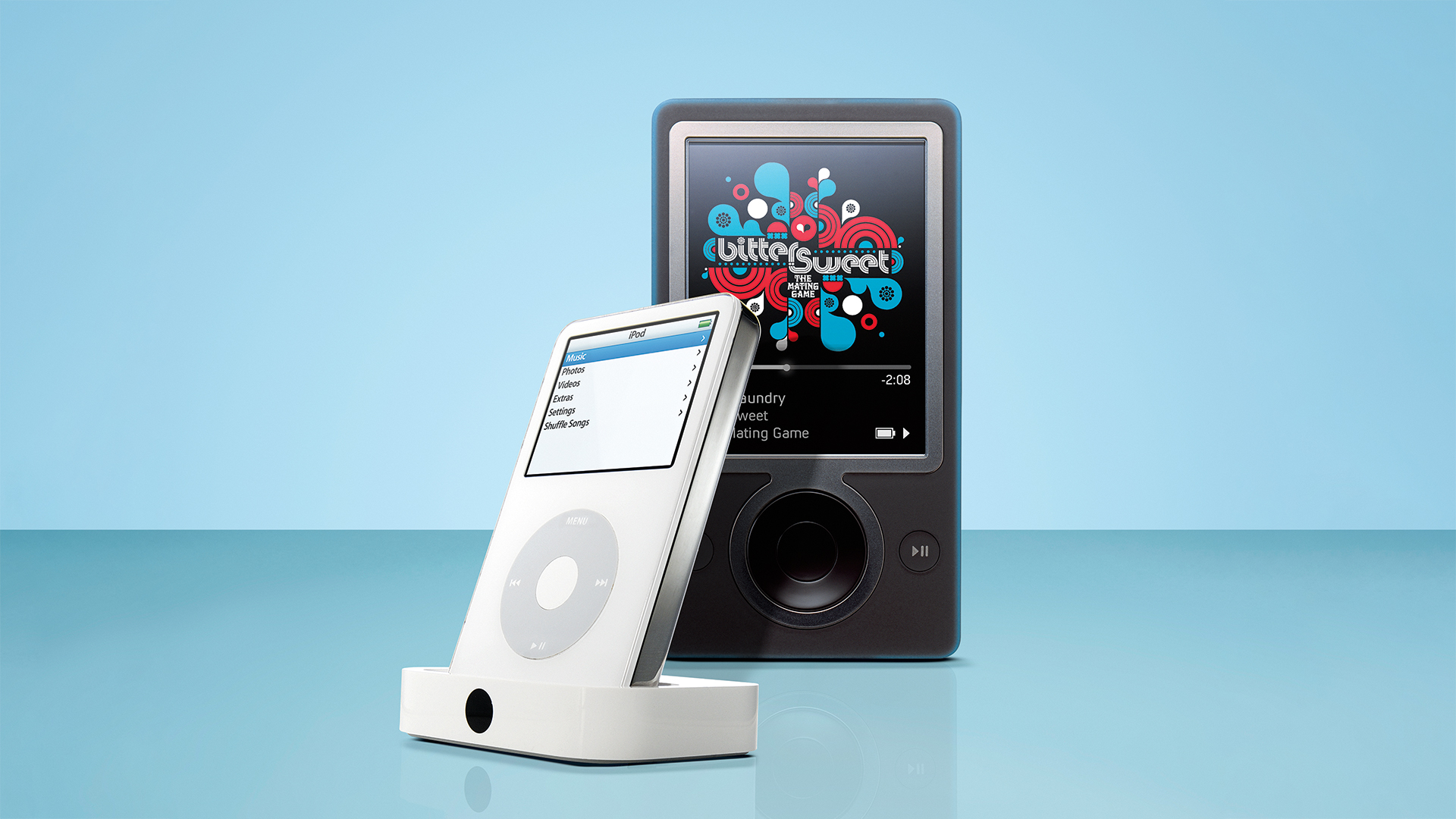
The first iPod, launched in 2001, wasn’t an overnight success. Available in white and chrome with a tiny monochrome screen, 5GB of storage and a mechanical scroll wheel, it was fairly limited. Equipped with FireWire, the only way to get any music onto it at all was to connect it to a suitably equipped Mac and sync it with iTunes. It was novel but it didn’t exactly set the tech world aflame.
It wasn’t until Apple released the second-gen that the iPod started to motor – available in 10GB and 20GB capacities, it now also synced with PCs. For five long years, it had the portable media player market sewn up: the first USB version arrived in 2003, followed by the colour-screen iPod photo and iPod mini (2004), the iPod nano (2004) and the iPod shuffle in 2006. Then the Zune arrived.
The Zune was Microsoft’s answer to the iPod and it was brilliant. Available in black, brown and white, it boasted a 30GB hard drive, a huge 7.6cm colour display and a circular directional control pad. It also gave you the ability to share your music wirelessly with friends, listen to podcasts, audiobooks and built-in FM radio, watch movies and TV and play games.
And the innovations kept coming. Long before Spotify, Tidal or Apple Music, the second-generation Zune (2007) gave us Zune Pass – an all-you-can-eat subscription based music service that was the complete opposite of iTunes’ buy-now-own-it-forever model, and Microsoft even gave you the ability to keep up to 10 downloads a month even after you cancelled your subscription.
Some mocked the Zune’s me-too-ness, some mocked its colour choices (brown, it’s your time to shine). Everyone thought a subscription-based music service was plain wrong (funny how that turned out). But the Zune also had a heck of a lot going for it. So what if it had been a smash success?
Get 3 issues of T3 for just £3 today!
Get every new issue of the UK's best-selling gadget magazine delivered direct to your door before it even hits the shops! And for a bargain price: get 3 issues for just £3 in our Autumn sale when you buy before 17th October at 10am (BST).
In 2009, Microsoft brought the Zune Video Marketplace to the Xbox, giving gamers the ability to buy or rent movies and TV shows on their consoles with music available via Zune Pass a year later. Let’s imagine this was the real turning point: as a result Zune sales and Zune Pass subscriptions soared.
People bought Zunes in huge numbers, especially the gaming-focused editions like Halo and Minecraft versions (the latter would be modular, enabling you to build your own). With Steve Jobs holding out against music subscriptions too long, the iPod faded away.
Get all the latest news, reviews, deals and buying guides on gorgeous tech, home and active products from the T3 experts
With the Zune killing the iPod on its own turf, Apple seemed all at sea. Jobs instinctively knew the Next Big Thing would be a portable, but Apple’s efforts were design dead-ends. The first was an iPod-successor with a built-in phone, which ill-advisedly used the iPod click wheel to input phone numbers. The second, once it had wised up to touchscreen, was a tablet to rival Microsoft’s Tablet PC that was power-hungry, MacBook- and OS-X-based.
While Apple flirted with disaster, Microsoft rushed headlong into the future. Buoyed by the success of the Zune, it launched its Zune HD-based Windows Phone OS in 2010 and it was an instant smash, being adopted by Nokia, HP and others. Then Samsung joined the party.
By 2011, Samsung was hitting its stride too, thanks to a decade of innovations in the mobile space that resulted in the Galaxy II S – the first smartphone of the modern era. Remarkable for its slab-like design, all-colour touchscreen and Home button, it proved that Samsung, not Apple, were the true tech innovators. The only thing Samsung lacked was an equally innovative OS to match, prompting a team up with Microsoft a year later, gaining Microsoft a dominant role in the world of phones as well as PCs.
